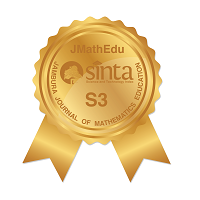Kemampuan Literasi Matematika Peserta Didik dalam Menyelesaikan Soal PISA Konten Space and Shape Ditinjau dari Gaya Kognitif
Abstract
Keywords
Full Text:
PDFReferences
I. K. Qadry, A. Dessa, and N. Aynul, "Analisis Kemampuan Literasi Matematika Siswa Dalam Menyelesaikan Soal Pisa Konten Space and Shape Pada Kelas Ix Smp Negeri 13 Makassar" J. Mat. dan Apl., vol. 2, no. 2, pp. 78-92, 2022.
S. Wardhani and Rumiati, Instrumen Penilaian Hasil Belajar Matematika SMP: Belajar dari PISA dan TIMSS. Yogyakarta: PPPPK Matematika, 2011.
OECD, PISA 2018: Insights and Interpretations. OECD Publishing, 2019.
E. F. Herliani and Wardono, "Perlunya Kemampuan Literasi Matematika Ditinjau Dari Gaya Kognitif dalam Pembelajaran Realistic Mathematics Education (RME)" Prism. Pros. Semin. Nas. Mat., pp. 234-238, 2019.
U. Umbara and D. Suryadi, "Re-interpretation of mathematical literacy based on the teacher's perspective" Int. J. Instr., vol. 12, no. 4, pp. 789-806, 2019.
D. Kusuma, Y. L. Sukestiyarno, W. Wardono, and A. N. Cahyo, "European Journal of Educational Research" Eur. J. Educ. Res., vol. 11, no. 1, pp. 193-206, 2021.
R. Masfufah and E. A. Afriansyah, "Analisis Kemampuan Literasi Matematis Siswa melalui Soal PISA" Mosharafa J. Pendidik. Mat., vol. 10, no. 2, pp. 291-300, 2021.
I. P. Ningsih, M. T. Budiarto, and S. Khabibah, "Literasi Spasial Siswa SMP Dalam Menyelesaikan Soal Geometri Ditinjau Dari Perbedaan Gaya Belajar" AKSIOMA J. Progr. Stud. Pendidik. Mat., vol. 10, no. 3, pp. 1531-1540, 2021.
F. Fadillah and D. R. Munandar, "Analisis kemampuan literasi matematis siswa pada soal PISA di SMPN 2 Karawang Barat" Wahana Mat. dan Sains, vol. 15, no. 3, pp. 15-25, 2021.
S. Sumardi and W. N. Aslami, "Analisis Tingkat Literasi Matematika Siswa Dalam Menyelesaiakan Soal Sistem Persamaan Linear Dua Variabel" AKSIOMA J. Progr. Stud. Pendidik. Mat., vol. 11, no. 2, p. 1453, 2022.
Mutia, K. N. S. Effendi, and Sutirna, "PISA-LIKE: Uncertainty and data content in Statistics subject with futsal context" J. Phys. Conf. Ser. 1778, 2021.
I. Kurniawati and I. Kurniasari, "Literasi Matematika Siswa Dalam Menyelesaikan Soal Pisa Konten Space and Shape Ditinjau Dari Kecerdasan Majemuk" MATHEdunesa, vol. 8, no. 2, pp. 441-448, 2019.
A. R. Taufik and N. Zainab, "Mathematical literacy of students in solving PISA-like problems based on cognitive styles of field-dependent and field-independent" J. Phys. Conf. Ser., vol. 1918, no. 4, 2021.
A. Hendroanto et al., "How Students Solves PISA Tasks: An Overview of Students' Mathematical Literacy" Int. J. Emerg. Math. Educ., vol. 2, no. 2, pp. 129-138, 2018.
M. N. Kholid et al., "What Are Students' Difficulties in Implementing Mathematical Literacy Skills for Solving PISA-Like Problem?" J. High. Educ. Theory Pract., vol. 22, pp. 181-200, 2022.
R. D. Lestari and K. N. S. Effendi, "Analisis Kemampuan Literasi Matematis Siswa SMP Pada Materi Bangun Datar" Biormatika J. Ilm. Fak. Kegur. dan ilmu Pendidik., vol. 8, pp. 63-73, 2022.
M. F. W. Utomo, H. Pujiastuti, and A. Mutaqin, "Analisis Kemampuan Literasi Matematika ditinjau dari Gaya Kognitif Siswa" KREANO J. Mat. Kreat. - Inov., vol. 11, pp. 185-193, 2020.
S. Sutama, Metode Penelitian Pendidikan Kuantitatif, Kualitatif, PTK, R&D. Kartasura: Fairuz Media, 2016.
H. A. Witkin, P. K. Oltman, E. Raskin, and S. A. Karp, A manual for the Group Embedded Figures Test. Menlo Park, CA: Mind Garden, lnc, 1971.
I. N. Sari et al., Metode Penelitian Kualitatif. Malang: Unisma Press, 2022.
OECD, PISA 2012 Assessment and Analytical Framework: MAthematics, Reading, Science, Problem Solving and Financial Literacy. OECD Publishing, 2013.
OECD, Programme for International Student Assessment. OECD Publishing, 2012.
A. R. Taufik and N. Zainab, "Mathematical literacy of students in solving PISA-like problems based on cognitive styles of field-dependent and field-independent" J. Phys. Conf. Ser. 1918, 2021.
A. Sahrina and I. B. Kusumawati, "Analisis Literasi Matematis Peserta Didik Kelas VII Ditinjau Dari Gaya Kognitif Field Dependent dan Field Independent" MATHEMA J. Pendidik. Mat., vol. 5, pp. 58-66, 2023.
A. A. Nugroho, N. Nizaruddin, I. Dwijayanti, and A. Tristianti, "Exploring students' creative thinking in the use of representations in solving mathematical problems based on cognitive style" JRAMathEdu (Journal Res. Adv. Math. Educ., vol. 5, pp. 202-217, 2020.
H. S. Kurniawan and R. P. Khotimah, "Profil Kemampuan Literasi Matematis Siswa Dalam Menyelesaikan Soal High Order Thinking Skill" AKSIOMA J. Progr. Stud. Pendidik. Mat., vol. 11, pp. 1966-1977, 2022.
Y. M. Sari and E. Valentino, "An Analysis of Students Error In Solving PISA 2012 And Its Scaffolding" JRAMathEdu (Journal Res. Adv. Math. Educ., vol. 1, pp. 90-98, 2017.
B. Murtiyasa and W. R. G. Perwita, "Analysis of mathematics literation ability of students in completing PISA-oriented mathematics problems with changes and relationships content" Univers. J. Educ. Res., vol. 8, pp. 3160-3172, 2020.
DOI: https://doi.org/10.34312/jmathedu.v4i1.18745
Refbacks
- There are currently no refbacks.
Copyright (c) 2023 Jambura Journal of Mathematics Education

This work is licensed under a Creative Commons Attribution-NonCommercial 4.0 International License.
Jambura Journal of Mathematics Education has been indexed by:
EDITORIAL OFFICE OF JAMBURA JOURNAL OF MATHEMATICS EDUCATION |
 | Department of Mathematics, Universitas Negeri Gorontalo Jl. Prof. Dr. Ing. B. J. Habibie, Moutong, Tilongkabila, Kabupaten Bone Bolango, Gorontalo 96554, Indonesia |
 | Email: [email protected] |
 | +6285255745923 (Call/SMS/WA) |
 | Jambura Journal of Mathematics Education (JMathEdu | eISSN: 2721-7477) by Department of Mathematics Universitas Negeri Gorontalo is licensed under a Creative Commons Attribution-NonCommercial 4.0 International License. Powered by Public Knowledge Project OJS. |



















